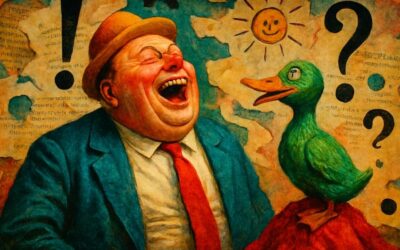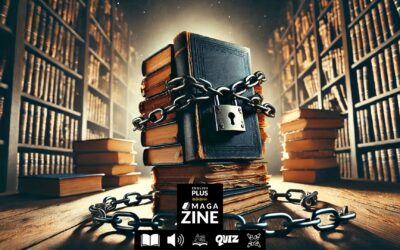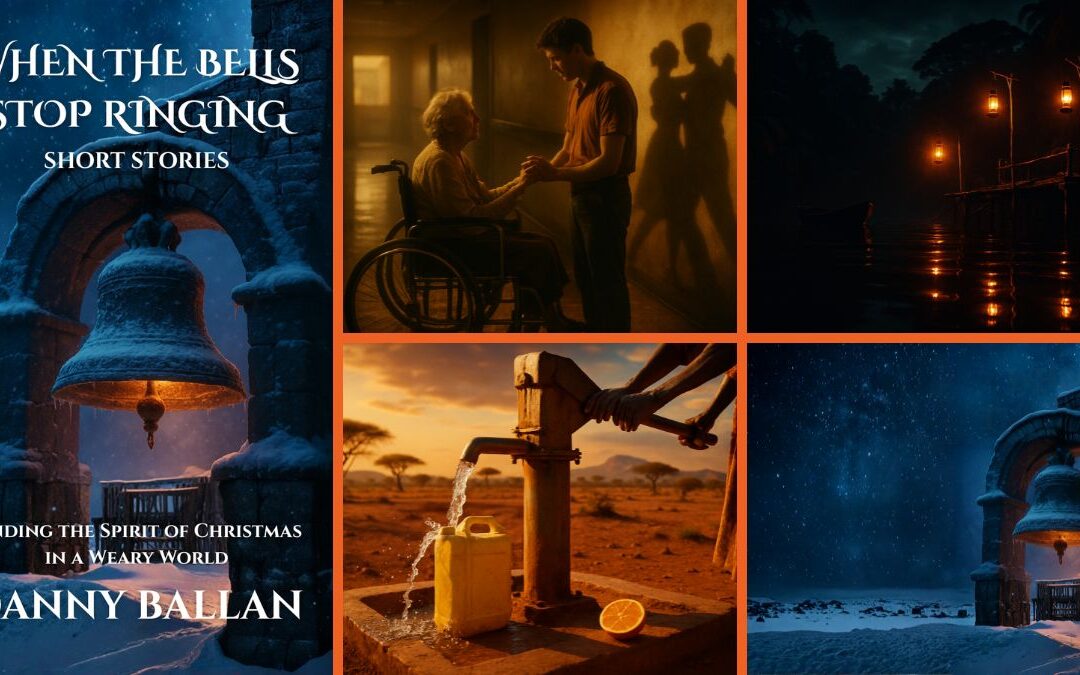- Defining the Dynamic Duo: Suspense vs. Tension
- The Suspense-Builder’s Toolkit: Techniques for Creating Anticipation
- Turning Up the Heat: Techniques for Creating Tension
- The Psychology of the Thrill: Why We Seek the Strain
- The Storyteller’s Balancing Act: Application and Control
- The Heartbeat of Compelling Narrative
- The Deep Dive
- Let’s Learn Vocabulary in Context
- Let’s Discuss
- Learn with AI
- Study Guide:The Art of Suspense and Tension in Storytelling
- Frequently Asked Questions About Suspense and Tension in Storytelling
- What are suspense and tension, and how do they differ in storytelling?
- What are some key techniques storytellers use to build suspense and keep audiences engaged?
- How do storytellers create tension within a scene or narrative?
- Why do audiences often enjoy experiencing suspense and tension in stories?
- How important is the balance between suspense and tension in effective storytelling?
- What does it mean to “show, don’t tell” when it comes to creating suspense and tension?
- What is the role of payoff in relation to the suspense that is built up in a story?
- Is the skillful use of suspense and tension only important for genres like thrillers and horror?
- Let’s Play & Learn
Think about the last time a book had you utterly captivated, reading long past your bedtime, desperate to know what happens next. Or recall a film that had you literally gripping the armrests, breath held, heart pounding. What creates that visceral, immersive experience? More often than not, it’s the masterful manipulation of two crucial narrative ingredients: suspense and tension. These twin forces are the invisible engines driving countless compelling stories, pulling audiences forward and forging a powerful emotional connection.
While often used interchangeably, suspense and tension are distinct, though related, elements that skilled storytellers wield with precision. Understanding how they work, both individually and together, is key not only for writers and filmmakers aiming to captivate their audience but also for readers and viewers who want to appreciate the craft behind the stories they love. This exploration delves into the electrifying world of narrative suspense and tension, dissecting their definitions, examining the techniques used to build them, and considering why we, as audiences, often crave these nail-biting experiences. Get ready to understand the palpable magic that keeps you hooked.
Defining the Dynamic Duo: Suspense vs. Tension
Though they frequently collaborate to create a gripping narrative, it’s useful to distinguish between these two powerful forces:
Suspense: The Anxious Wait for What’s Next
Suspense is primarily about anticipation and uncertainty. It’s the state of anxious curiosity the audience feels about the outcome of events, particularly when potential danger or significant consequences are involved. Suspense hinges on questions:
- Will the hero escape the villain’s clutches?
- Will the lovers finally confess their feelings before it’s too late?
- What secret is being hidden?
- Will the detective solve the case before the killer strikes again?
It’s generated by making the audience aware of potential risks or desired outcomes but delaying the revelation of what will actually happen. The core feeling is one of wanting – often desperately – to know the answer or see the resolution.
Tension: The Feeling of Strain and Conflict
Tension, on the other hand, is more about the feeling of strain, pressure, friction, or unresolved conflict within a scene or narrative. It’s the charged atmosphere, the palpable sense of unease or struggle. Tension can arise from:
- Direct conflict between characters (arguments, fights, power struggles).
- Internal conflict within a character (dilemmas, fears, contradictory desires).
- Situational pressure (a dangerous environment, limited resources, social awkwardness).
- Unspoken issues or subtext simmering beneath the surface of interactions.
While suspense often asks “What will happen?”, tension makes us feel the strain of what is happening now. A scene can be tense even if we’re fairly certain of the outcome, simply due to the emotional or situational pressure involved. Often, tension builds towards a moment of suspenseful uncertainty.
The Suspense-Builder’s Toolkit: Techniques for Creating Anticipation
Crafting effective suspense relies on carefully controlling the flow of information and managing audience expectations. Here are key techniques:
Withholding Information (The Art of the Reveal)
This is fundamental. Storytellers create suspense by deliberately withholding crucial information from the audience or specific characters. Who is the traitor? What’s behind the locked door? What really happened that night? By revealing clues or pieces of the puzzle slowly, the storyteller keeps the audience guessing, theorizing, and desperate for the full picture. However, this must be handled carefully; withholding information arbitrarily can feel frustrating or manipulative.
Dramatic Irony (The Audience Advantage)
One of the most powerful suspense techniques involves letting the audience know more than the characters do. Alfred Hitchcock, the undisputed master of suspense, famously illustrated this with his “bomb theory”: show the audience there’s a bomb under the table set to go off in five minutes, but the characters chatting obliviously don’t know it. The audience feels intense suspense for the characters, anticipating the explosion or hoping they discover the danger in time. We know the killer is in the house, but the protagonist doesn’t. This creates a powerful sense of empathy and helpless anticipation.
Foreshadowing (Whispers on the Wind)
As discussed previously in the context of chapter endings, foreshadowing involves planting subtle hints or clues about future events. In building suspense, foreshadowing often takes an ominous tone, suggesting danger or trouble ahead without explicitly stating it. A dark weather forecast, a strange comment, a recurring symbol – these can create a growing sense of unease and make the audience nervously anticipate when the hinted event will occur.
Raising the Stakes (Making it Matter)
Suspense is amplified when the consequences of failure are significant. Storytellers must clearly establish what the protagonist (and potentially others) stands to lose. Are the stakes life or death? Is reputation, love, freedom, or the fate of the world on the line? The higher the stakes, and the more the audience cares about the characters involved, the more potent the suspense becomes.
The Ticking Clock (Imposing Time Limits)
Introducing a deadline or a limited timeframe automatically injects urgency and suspense. The hero must defuse the bomb before it detonates. The antidote must be found before the poison takes full effect. The escape must happen before the guards return. Time constraints force action and prevent characters (and the audience) from relaxing, constantly reminding them that time is running out.
Posing Questions (Igniting Curiosity)
Effective suspense often relies on planting questions in the audience’s mind. These can be overt mysteries (“Who dunnit?”) or more subtle character-based questions (“Will she find the courage?”). Each unanswered question acts like a hook, keeping the audience engaged and invested in discovering the answer.
Turning Up the Heat: Techniques for Creating Tension
While related to suspense, building tension often focuses more on atmosphere, conflict, and the internal/interpersonal dynamics of a scene.
Conflict is King (Internal, Interpersonal, External)
Tension thrives on conflict. This can be:
- Internal: A character grappling with a difficult dilemma, battling fear, or wrestling with contradictory desires creates internal tension.
- Interpersonal: Arguments, rivalries, power struggles, misunderstandings, or the presence of an antagonist working against the protagonist generate friction and tension between characters.
- External: Placing characters in dangerous environments, facing natural disasters, or struggling against societal forces creates situational tension.
The more intense and unresolved the conflict, the higher the tension.
Pacing and Rhythm (Manipulating Time)
How a scene unfolds in time significantly impacts tension.
- Slowing Down: Stretching out a critical moment, focusing on small details and sensory input, can make a tense situation feel almost unbearable (e.g., the slow creak of a floorboard as someone hides).
- Speeding Up: Using short sentences, quick cuts (in film), or rapid sequences of events can create a frantic, breathless tension.
- Juxtaposition: Alternating between fast-paced action and moments of uneasy calm can create a jarring rhythm that enhances overall tension.
Atmosphere and Setting (The Power of Place)
The environment itself can be a source of tension. Descriptions that emphasize darkness, isolation, claustrophobia, decay, or unsettling sounds contribute to an atmosphere of unease. Think of haunted houses, desolate landscapes, or sterile, oppressive institutions. Sensory details are key to making the setting feel palpable and threatening.
Unspoken Issues and Subtext (What Lies Beneath)
Often, the greatest tension resides in what isn’t being said explicitly. Dialogue filled with subtext – hidden meanings, veiled threats, unspoken desires, or simmering resentments – can create incredibly charged interactions. Awkward silences, loaded glances, and evasive answers can be more tension-filled than an open argument.
Point of View (Through Whose Eyes?)
Limiting the audience’s perspective can significantly increase tension. Experiencing events solely through the eyes of a character who is scared, confused, unreliable, or in danger immerses the audience in their subjective experience of tension. A close third-person or first-person POV often excels at this.
The Psychology of the Thrill: Why We Seek the Strain
Why do we actively seek out stories that make us feel anxious and tense? Psychologically, there are several reasons:
- Engagement: Suspense and tension demand our full attention, pulling us out of our everyday concerns and fully immersing us in the narrative world.
- Problem-Solving: Suspense often presents mysteries or problems, engaging our cognitive drive to figure things out and predict outcomes.
- Emotional Range: Experiencing strong emotions like fear and anxiety in a safe, controlled environment can be exhilarating and provide a vicarious thrill.
- Catharsis: The eventual release of built-up tension can be intensely pleasurable and emotionally satisfying – a feeling known as catharsis.
The Storyteller’s Balancing Act: Application and Control
Mastering suspense and tension requires more than just knowing the techniques; it requires skillful application.
The Importance of Ebb and Flow
Relentless, non-stop suspense and tension can be exhausting and counterproductive. Effective storytelling requires modulation – building tension, providing moments of release or lower intensity, and then allowing things to escalate again. This contrast makes the high points more impactful.
Show, Don’t Just Tell
Instead of stating “The room was tense,” show the tension through characters’ actions (clenched fists, shallow breathing), dialogue (short, clipped responses, loaded silences), and atmospheric details (ticking clock, shadows). Let the audience feel it.
The Promise of Payoff
When you build suspense around a question or a threat, the audience expects some form of payoff or resolution eventually. While ambiguity can be effective (as in the Sailor ending), completely failing to address major sources of suspense can feel unsatisfying or like a narrative cheat. Tension, similarly, usually needs to break or transform in some way.
The Heartbeat of Compelling Narrative
Suspense and tension are the lifeblood of engaging storytelling. They are the tools writers and filmmakers use to grab our attention, compel us forward, forge empathetic connections with characters, and create memorable, emotionally resonant experiences. While suspense primarily plays on our anxious curiosity about the future, tension makes us feel the strain and pressure of the present moment. By understanding and skillfully employing techniques like withholding information, dramatic irony, pacing manipulation, raising the stakes, and cultivating atmosphere, storytellers can transform a simple sequence of events into an edge-of-your-seat journey. Mastering this art isn’t just for thriller writers; it’s essential for anyone who wants to create narratives that truly live and breathe, leaving the audience both satisfied and breathless.
The Deep Dive
Let’s Learn Vocabulary in Context
Let’s delve into some of the specific vocabulary we used while exploring the art of suspense and tension. These words are fantastic for adding precision when discussing stories, films, or even real-life situations involving anticipation and pressure. We’ll look at about ten key terms.
First, we described the feeling of tension as often being palpable. Palpable means able to be touched or felt. When used figuratively, it means so intense as to seem almost tangible or easily perceived. If tension or excitement in a room is palpable, you can feel it very strongly, almost as if it’s a physical presence in the air. It’s much stronger than just saying “there was tension.” You could say, “The excitement in the stadium was palpable before the final match,” or “There was a palpable sense of relief when the crisis was averted.” It emphasizes the intensity and obviousness of a feeling or atmosphere.
We talked about the need for tension to sometimes release, and then escalate again. To escalate means to increase rapidly; to become or make more intense or serious. In storytelling, tension doesn’t usually stay at one level. It escalates – builds up – towards a climax or confrontation. Storytellers carefully manage this escalation to keep the audience engaged without overwhelming them too early. Outside of stories, we talk about situations escalating: “The minor disagreement quickly escalated into a full-blown argument,” or “The company is worried about escalating costs.” It implies an increase in intensity or seriousness.
A powerful tool for creating tension is subtext. We mentioned dialogue filled with subtext. Subtext refers to the implicit or metaphorical meaning of a text; the underlying message or theme that is not explicitly stated or shown. In dialogue, subtext is what a character really means, feels, or wants, hidden beneath the surface of what they are actually saying. A conversation might seem polite on the surface, but the subtext could be full of resentment, desire, or threat, creating significant tension. Understanding subtext is key to analyzing literature, film, and even real-life communication. “Although they spoke calmly, the subtext of their conversation was clearly hostile.”
Internal conflict often involves a character facing a dilemma. A dilemma, as we saw before, is a situation in which a difficult choice has to be made between two or more alternatives, especially equally undesirable ones. Placing a character in a dilemma – forcing them to make a tough choice with significant consequences – is a classic way to create internal tension and suspense. Will they sacrifice themselves or their friend? Will they choose duty or love? The audience feels the strain of the decision. “She faced the dilemma of whether to report her colleague’s misconduct or stay silent.”
In many stories involving conflict, we have an antagonist. The antagonist is a person who actively opposes or is hostile to someone or something; an adversary. In storytelling, the antagonist is typically the character (or force, like nature or society) who opposes the main character, the protagonist. The antagonist creates conflict, obstacles, and often danger, driving the plot forward and generating tension and suspense. Think of classic villains like Darth Vader or Professor Moriarty. “The determined detective was a worthy antagonist for the cunning jewel thief.”
The main character, facing the antagonist or other challenges, is the protagonist. The protagonist is the leading character or one of the major characters in a drama, film, novel, or other fictional text. We usually experience the story primarily through the protagonist’s perspective, and their goals, struggles, and potential fate are the main drivers of suspense and tension. We root for the protagonist (usually!) and feel anxious about the challenges they face. “Harry Potter is the protagonist of J.K. Rowling’s famous series.”
Suspense is higher when the stakes are high. Stakes refer to what is at risk in a situation, game, or contest; the potential consequences of success or failure. In storytelling, raising the stakes means making sure the audience understands that something important is at risk if the protagonist fails. Are they risking their life, their family, their reputation, the world? The higher the stakes, the more invested the audience becomes and the greater the suspense. You might talk about “high-stakes negotiations” or say “the stakes are too high” to take a certain risk. “For the climbers, the stakes were incredibly high – one wrong move meant certain death.”
A key technique for building suspense is withholding information. To withhold means to refuse to give (something that is due to or desired by another); to hold back or suppress. Storytellers deliberately withhold information about the plot, characters’ motives, or future events to create mystery and make the audience eager to learn more. Revealing information gradually keeps the suspense alive. In real life, someone might “withhold payment” until a job is done, or “withhold judgment” until they have all the facts. “The company was accused of withholding crucial safety information from its employees.”
The release of tension and suspense can lead to a feeling of catharsis. Catharsis is the process of releasing, and thereby providing relief from, strong or repressed emotions. In the context of drama and literature (originating with Aristotle), catharsis refers to the purification or purgation of emotions (especially pity and fear) primarily through art. Experiencing intense suspense and tension in a story, and then seeing it resolved (even tragically), can provide a sense of emotional release and cleansing for the audience. “Watching the tragic play was a deeply cathartic experience for her.”
Finally, we often experience these feelings vicariously. Vicarious means experienced in the imagination through the feelings or actions of another person. When we feel suspense for a character in danger, or tension during their struggles, we are experiencing those emotions vicariously. We aren’t actually in danger, but we feel the thrill or anxiety through the character. Reading books, watching films, and even following sports teams often involves vicarious experiences. “He gets a vicarious thrill from watching extreme sports.” “Parents often feel a vicarious sense of pride in their children’s accomplishments.”
Words like palpable, escalate, subtext, dilemma, antagonist, protagonist, stakes, withholding, cathartic, and vicarious are essential for analyzing how stories manipulate our emotions and keep us utterly engaged.
Let’s Discuss
Here are some questions to spark deeper thought and conversation about suspense and tension in storytelling:
- Your Suspense Threshold: What’s your personal tolerance for suspense and tension in stories? Do you actively seek out thrilling narratives, or do you prefer stories with less intense conflict? Why?
- Consider: Are there certain types of suspense (e.g., physical danger vs. psychological) you enjoy more than others? Have your preferences changed over time? Discuss what makes suspense enjoyable versus stressful for different people.
- Hitchcock’s Bomb Theory: Think about dramatic irony (where the audience knows more than the character). Can you recall a specific example from a book or film where this technique was used effectively? What made it work?
- Consider: How did knowing something the character didn’t make you feel? Did it increase your anxiety for them? Did it change how you viewed their actions? Discuss the power of this audience advantage.
- Tension Without Action: Can a story create significant tension with very little happening externally? Think about scenes focused on dialogue, internal thoughts, or atmosphere. What techniques make these quiet scenes tense?
- Consider: The power of subtext, internal conflict (dilemmas), claustrophobic settings, loaded silences, or an unreliable narrator’s perspective. Share examples of stories that create tension through psychological means rather than just action.
- The Ethics of Manipulation: Storytellers deliberately manipulate audience emotions using suspense and tension. When does this cross the line from engaging craft into feeling cheap, exploitative, or emotionally draining?
- Consider: Is it about the payoff (does the suspense lead anywhere meaningful)? The type of emotion being evoked (fear vs. dread)? The frequency (relentless tension)? Discuss where you draw the line as an audience member.
- Beyond Thrillers: While obvious in thrillers and horror, how are suspense and tension used effectively in other genres like romance, comedy, drama, or even literary fiction?
- Consider: Will they/won’t they tension in romance? The tension of awkward comedic situations? The internal tension of dramatic character choices? The subtle narrative tension created by unreliable narrators or unresolved thematic questions in literary works. Share examples from unexpected genres.
Learn with AI
Disclaimer:
Because we believe in the importance of using AI and all other technological advances in our learning journey, we have decided to add a section called Learn with AI to add yet another perspective to our learning and see if we can learn a thing or two from AI. We mainly use Open AI, but sometimes we try other models as well. We asked AI to read what we said so far about this topic and tell us, as an expert, about other things or perspectives we might have missed and this is what we got in response.
Hello story enthusiasts! Suspense and tension – they really are the secret sauce, aren’t they? The article did a great job breaking down the core techniques. Let me add a couple of extra layers that writers and analysts often mull over.
One distinction that’s really potent is the difference between suspense and surprise. Hitchcock himself emphasized this. Surprise is when something shocking happens unexpectedly (like a sudden jump scare). Suspense, as we discussed, is when the audience anticipates something happening, often because they have more information than the character (the bomb under the table). While surprise provides a momentary jolt, Hitchcock argued that suspense provides sustained engagement and greater emotional investment. A good storyteller often uses both, but understanding when to deploy a sudden shock versus building prolonged anticipation is key.
Let’s talk about micro-tension. We often think of tension on a scene or plot level, but effective writers build micro-tension even within paragraphs or sentences. This can be done through:
- Word choice: Using loaded verbs or unsettling adjectives.
- Sentence structure: Short, choppy sentences can create unease, while long, complex sentences can mimic a character’s racing thoughts or a drawn-out moment.
- Sensory details: Focusing on unsettling sounds, smells, or tactile sensations.
- Intriguing questions within narration: Even a simple internal thought like “What was that noise?” can inject a tiny jolt of tension. Layering these micro-tensions keeps the reader subtly engaged even in quieter moments.
Another powerful tool, especially in written fiction, is the unreliable narrator. When the audience suspects the person telling the story isn’t being entirely truthful or perceives reality accurately, it creates a unique form of suspense and tension. We’re constantly questioning what’s real, what agenda the narrator has, and anticipating the moment the truth (or a different version of it) will be revealed. It forces active engagement from the reader.
Consider also the role of setting as an active participant in building tension. It’s not just a backdrop. Think about how a house in a horror story isn’t just a location, but often feels like a malevolent entity itself, actively working against the characters through strange noises, locked doors, or hidden passages. Using setting details dynamically – changing weather, decaying environments, objects that seem out of place – can significantly amplify tension.
Finally, don’t underestimate the power of character emotional response. Often, the audience gauges the level of tension based on how the characters are reacting. If the protagonist remains calm in a dangerous situation, the tension might feel lower (or it might create tension via dramatic irony if we know they shouldn’t be calm!). Showing fear, anxiety, or determination through physical reactions (shaking hands, shallow breath, gritted teeth) makes the tension palpable for the reader who experiences it vicariously.
So, thinking about surprise vs. suspense, building micro-tension, leveraging unreliable narrators, using setting actively, and focusing on character reaction can add even more sophistication to how we understand and create these vital storytelling elements.
Study Guide:The Art of Suspense and Tension in Storytelling
Key Concepts Review
- Distinction between Suspense and Tension: Understand the fundamental difference between suspense (anticipation of what might happen) and tension (the feeling of strain or conflict in the present moment).
- Suspense as Anxious Wait: Recall that suspense centers on uncertainty about future outcomes and often involves questions in the audience’s mind.
- Tension as Present Strain: Recognize that tension focuses on the immediate feeling of pressure, conflict, or unease within a scene.
- Interplay of Suspense and Tension: Understand how these two elements often work together to create a gripping narrative.
- Techniques for Building Suspense: Be familiar with the following techniques and how they create anticipation:
- Withholding Information
- Dramatic Irony
- Foreshadowing
- Raising the Stakes
- The Ticking Clock
- Posing Questions
- Techniques for Building Tension: Be familiar with the following techniques and how they create a feeling of strain:
- Conflict (Internal, Interpersonal, External)
- Pacing and Rhythm
- Atmosphere and Setting
- Unspoken Issues and Subtext
- Point of View
- Psychological Reasons for Seeking Thrill: Understand why audiences are drawn to stories that evoke suspense and tension (engagement, problem-solving, emotional range, catharsis).
- Importance of Balance (Ebb and Flow): Recognize that effective storytelling modulates suspense and tension, providing moments of release.
- “Show, Don’t Tell”: Understand the importance of demonstrating suspense and tension through actions, dialogue, and atmosphere rather than simply stating them.
- The Promise of Payoff: Recall that built-up suspense and tension generally require some form of resolution or transformation to satisfy the audience.
Short-Answer Quiz
Answer the following questions in 2-3 sentences each.
- What is the primary difference between suspense and tension in storytelling?
- Explain how withholding information can be used as a technique to build suspense.
- Describe the narrative device of dramatic irony and how it contributes to audience suspense.
- Give an example of how foreshadowing can create a sense of unease and anticipation in a story.
- Why is “raising the stakes” an effective method for amplifying suspense in a narrative?
- How does the use of a “ticking clock” scenario typically impact the level of suspense in a story?
- Describe how internal conflict within a character can generate tension for the audience.
- Explain how manipulating pacing and rhythm in a scene can contribute to building tension.
- What role does atmosphere and setting play in creating a tense mood in a story?
- According to the text, what is one psychological reason why audiences might seek out stories that contain suspense and tension?
Answer Key for Short-Answer Quiz
- Suspense is primarily about the audience’s anxious anticipation for what might happen next and relies on uncertainty. Tension, on the other hand, is the feeling of strain, pressure, or unresolved conflict that exists in the present moment of the narrative.
- By deliberately withholding crucial information from the audience or characters, storytellers create suspense. This lack of knowledge ignites curiosity and makes the audience eager to uncover the missing pieces of the puzzle.
- Dramatic irony occurs when the audience is aware of information that one or more characters in the story are not. This creates suspense as the audience anticipates the characters’ eventual discovery or the consequences of their ignorance.
- Foreshadowing involves subtly hinting at future events, often with an ominous tone. This can create a growing sense of unease and make the audience nervously anticipate when the hinted danger or trouble will materialize.
- Raising the stakes amplifies suspense by making the potential consequences of failure significant for the characters the audience cares about. When life, reputation, or other crucial aspects are on the line, the audience becomes more invested in the outcome.
- The use of a “ticking clock” or a limited timeframe injects urgency and intensifies suspense. Knowing that time is running out forces action and creates anxiety about whether the characters will succeed before the deadline.
- Internal conflict, where a character grapples with dilemmas, fears, or contradictory desires, generates tension by creating a sense of unease and struggle within the individual. The audience feels the character’s internal pressure and anticipates the outcome of their struggle.
- Slowing down critical moments can heighten tension by focusing on minute details and sensory input, making the audience feel the weight of the situation. Conversely, speeding up the pace with quick cuts and rapid events can create a frantic, breathless tension.
- Atmosphere and setting can establish a tense mood by using descriptions that emphasize unsettling elements such as darkness, isolation, claustrophobia, or disturbing sounds. These sensory details create a palpable feeling of unease for the audience.
- One psychological reason audiences seek out suspense and tension is engagement; these elements demand our full attention, pulling us into the narrative and away from our everyday concerns, creating a fully immersive experience.
Essay Format Questions
Consider the following questions for a more in-depth analysis of the source material.
- Discuss the relationship between suspense and tension, explaining how they function both independently and in conjunction to create a captivating narrative experience. Provide specific examples of techniques that contribute to each and how they might be used together.
- Analyze the various techniques a storyteller can employ to build suspense effectively. Evaluate which techniques you find most impactful and explain your reasoning, using examples from literature or film (not provided in the source) to support your claims.
- Explore the different forms of conflict (internal, interpersonal, external) and discuss how each can be utilized to generate tension within a narrative. Provide examples of how storytellers might effectively portray each type of conflict to engage the audience.
- Examine the psychological reasons why audiences are drawn to stories that evoke feelings of suspense and tension. Discuss the concepts of engagement, problem-solving, emotional range, and catharsis in relation to the appeal of these narrative elements.
- Evaluate the importance of balance and control in the effective use of suspense and tension. Discuss the potential pitfalls of overusing or mismanaging these elements and suggest strategies for achieving a satisfying and impactful narrative experience.
Glossary of Key Terms
- Suspense: A narrative device that creates a feeling of anxious uncertainty about the outcome of events, often involving potential danger or significant consequences. It hinges on questions and the anticipation of their answers.
- Tension: A narrative device that creates a feeling of strain, pressure, friction, or unresolved conflict within a scene or narrative. It focuses on the immediate unease and struggle of the present moment.
- Withholding Information: A suspense technique where the storyteller deliberately omits crucial details from the audience or specific characters, creating curiosity and speculation.
- Dramatic Irony: A suspense technique where the audience is aware of information that one or more characters in the story are not, leading to anticipation and concern for the characters.
- Foreshadowing: A narrative technique of providing subtle hints or clues about future events, often creating a sense of unease or anticipation.
- Raising the Stakes: A suspense technique that amplifies the potential consequences of failure for the characters, increasing the audience’s investment in the outcome.
- Ticking Clock: A suspense technique that introduces a deadline or limited timeframe, creating a sense of urgency and pressure.
- Conflict (Internal): Tension arising from a character’s struggle with their own thoughts, feelings, beliefs, or desires.
- Conflict (Interpersonal): Tension arising from direct clashes, disagreements, or power struggles between two or more characters.
- Conflict (External): Tension arising from a character’s struggle against outside forces such as nature, society, or antagonistic characters.
- Pacing: The speed at which a narrative unfolds, which can be manipulated to increase or decrease tension.
- Atmosphere: The overall feeling or mood of a scene or setting, often created through sensory details and descriptions, which can contribute to tension.
- Subtext: The underlying or implicit meaning in dialogue or actions that is not explicitly stated, often creating tension and unspoken conflict.
- Point of View (POV): The perspective from which the story is told, which can be limited to a single character to heighten their experience of tension for the audience.
- Catharsis: The emotional release experienced by the audience at the resolution of built-up suspense or tension.
Frequently Asked Questions About Suspense and Tension in Storytelling
What are suspense and tension, and how do they differ in storytelling?
Suspense is the feeling of anxious anticipation and uncertainty about future events in a story, driven by questions like “What will happen next?” It arises from making the audience aware of potential dangers or desired outcomes while delaying their resolution. Tension, on the other hand, is the feeling of strain, pressure, or unresolved conflict within a specific scene or throughout the narrative. It focuses on the present moment and can stem from character conflicts (internal or external), situational pressures, or unspoken subtext. While distinct, suspense and tension often work together to create a gripping narrative experience.
What are some key techniques storytellers use to build suspense and keep audiences engaged?
Storytellers employ various techniques to cultivate suspense, including: withholding information to create mystery and encourage speculation; using dramatic irony where the audience knows more than the characters, generating anticipation and concern; foreshadowing future events through subtle hints and clues to create a sense of unease; raising the stakes by emphasizing the significant consequences of failure; introducing a ticking clock or deadline to create urgency; and posing questions that pique the audience’s curiosity and desire for answers.
How do storytellers create tension within a scene or narrative?
Tension is often built through: depicting various forms of conflict – internal struggles within a character, interpersonal conflicts between characters, or external conflicts with the environment or circumstances; manipulating pacing and rhythm, such as slowing down crucial moments or speeding up action sequences; establishing a tense atmosphere and setting through vivid descriptions and sensory details; utilizing unspoken issues and subtext in dialogue and interactions to create underlying unease; and carefully controlling the point of view to immerse the audience in a character’s experience of pressure or fear.
Why do audiences often enjoy experiencing suspense and tension in stories?
People are drawn to stories with suspense and tension for several psychological reasons. These include the deep engagement that these elements demand, pulling us into the narrative; the opportunity for problem-solving as we try to predict outcomes and understand mysteries; the vicarious thrill of experiencing strong emotions like fear and anxiety in a safe context; and the satisfying release of built-up tension, known as catharsis, at the story’s resolution.
How important is the balance between suspense and tension in effective storytelling?
Maintaining a balance between suspense and tension is crucial. Relentless suspense or tension can become exhausting and lose its impact. Effective storytelling involves modulating these elements, building them up, providing moments of release or lower intensity, and then allowing them to escalate again. This ebb and flow keeps the audience engaged without overwhelming them and makes the high points of suspense and tension more impactful.
What does it mean to “show, don’t tell” when it comes to creating suspense and tension?
Instead of explicitly stating that a scene is suspenseful or tense, storytellers should “show” these qualities through concrete details. This involves describing characters’ actions (e.g., fidgeting hands, strained voices), their dialogue (e.g., short, clipped sentences, loaded silences), and the surrounding atmosphere (e.g., a dripping sound in a silent room, oppressive heat). By allowing the audience to infer the suspense and tension through sensory details and character behavior, the experience becomes more immersive and impactful.
What is the role of payoff in relation to the suspense that is built up in a story?
When a storyteller builds suspense around a particular question, threat, or mystery, the audience develops an expectation of a payoff or resolution. While some ambiguity can be effective, especially in certain genres, completely failing to address major sources of suspense can leave the audience feeling unsatisfied or even cheated. The eventual revelation or confrontation should feel earned and meaningful in relation to the anticipation that was carefully constructed. Similarly, built-up tension usually needs to break or transform in a significant way.
Is the skillful use of suspense and tension only important for genres like thrillers and horror?
While suspense and tension are central to genres like thrillers and horror, they are valuable tools for almost any type of storytelling. Creating anticipation, highlighting conflicts, and generating emotional investment are crucial for engaging audiences across all genres, including drama, romance, comedy, and even literary fiction. The masterful manipulation of these elements can elevate any narrative, making it more compelling and emotionally resonant, regardless of the specific subject matter.










0 Comments